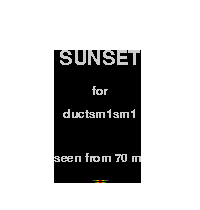
In this simulation, the thermal inversion is considerably stronger than in the previous example. We now have a 2 K thermal inversion (which is still not a very strong inversion), spread over the 10 meters from 50 to 60 m of height. The ray curvature in the inversion is nearly twice the curvature of the Earth's surface, so a duct is formed. The observer is only a little above the duct, at 70 meters.

Notice that the blob eventually joins the main image above it, and fuses to it, with no gap between them. This is the hallmark of mock mirages, whether ducted or not. The joining of the two images always occurs, if the observer is completely above the inversion layer. (Contrast this with the same sunset as seen from within the inversion, where a blank strip separates the Sun into two separate images.) In reality, the line where the lower and upper images join is a discontinuity in refraction, airmass, and extinction; so it usually is quite visible because the image is much brighter above the line than below it. But this simple simulation does not try to represent such details. (A few more realistic images of this sunset, seen from 65m height, are shown on another page.)
The end of this sunset is striking: the Sun becomes at first almost rectangular; then the sides of the rectangle collapse to form an “hourglass” shape, which forms a pair of horizontal lines after its neck breaks. The upper half of the hourglass (which is an inverted image of the Sun's upper limb) disappears very slowly, greatly prolonging the sunset.
There is very little indication of a green flash. In actuality, there is even less, because the large refraction produced by the duct greatly increases the extinction and reddening of the light. In practice, these sunsets never produce green flashes.
However, what is lost to the observer above the inversion is gained by one below it. The remarkable sub-duct flash is visible to the lucky observer whose eye is just below the duct.
© 1999 – 2003, 2005 – 2007, 2012 Andrew T. Young